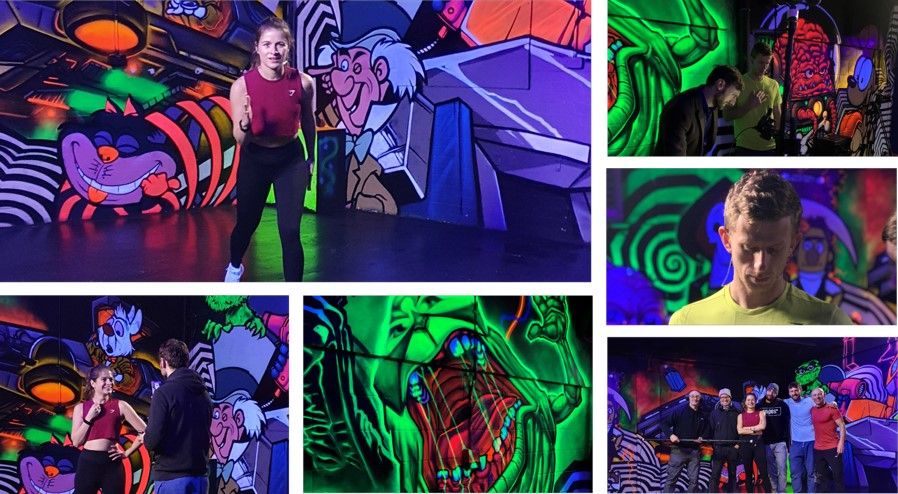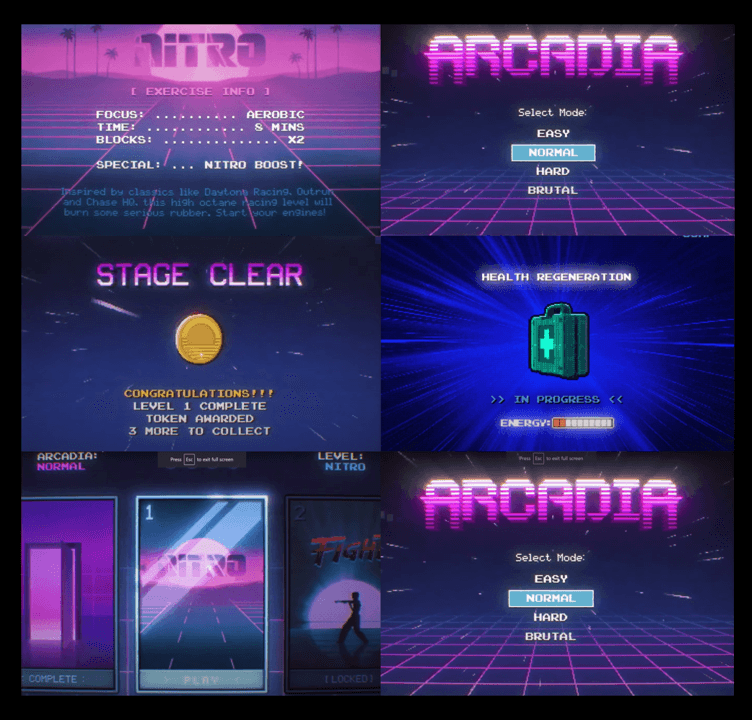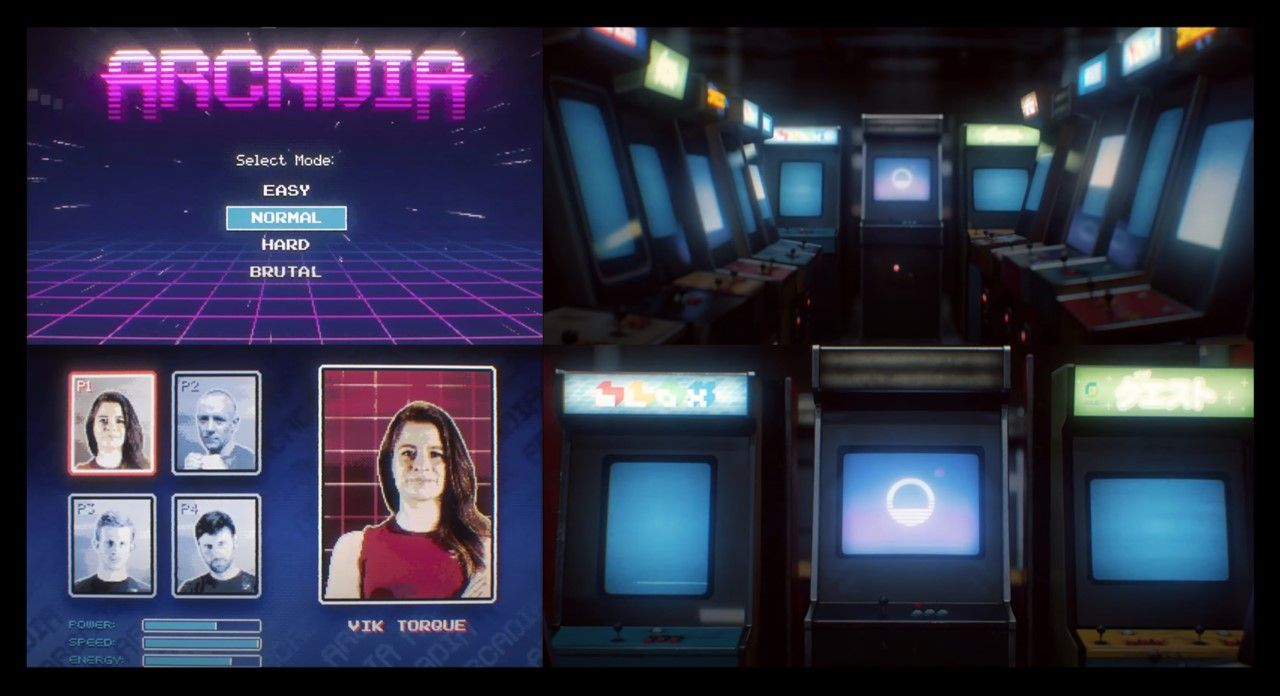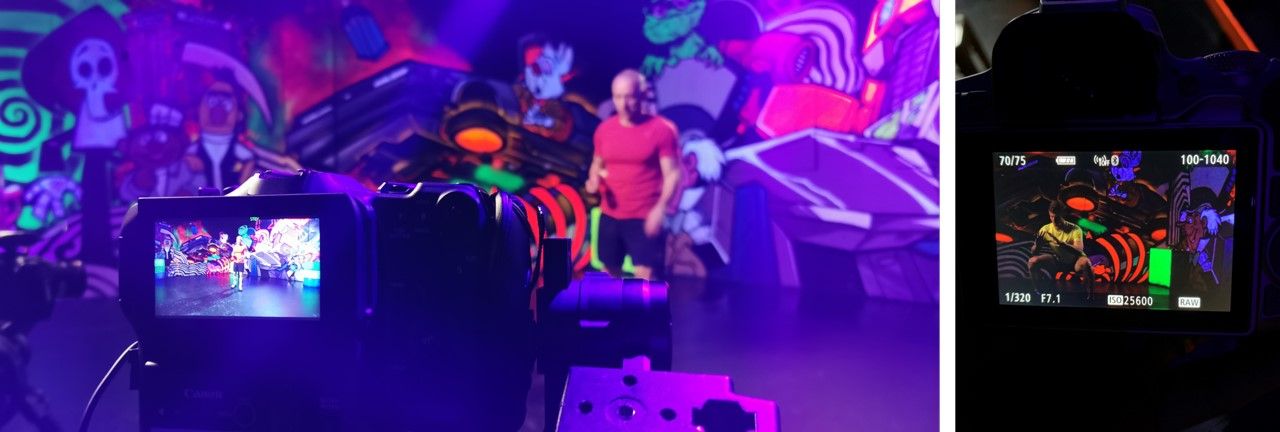What we learnt making YouTube's most brutal workout - ARCADIA
Behind the scenes of YouTube's most brutal workout - ARCADIA
Earlier this year, along with my co-founder Adrian Iliescu, I produced a pilot workout called ARCADIA. This high-intensity cardio workout fuses the aesthetics of the 1990s arcade era, rhythm game style music, bespoke authentic animations, special effects and creative choreography.
I have always wanted workouts to be akin to TV episodes, based on music, film and gaming, so took the opportunity to create a workout that looked, sounded and hopefully felt different to the content you get with Video on Demand platforms.
During the lockdown, I spent a lot of time crafting workouts, complete with cinematic trailers, to stream through Zoom with friends. This included Alien V Terminator, Brutal Berlin and Race to Rio. These were time-consuming to put together, but let’s face it, there was plenty of that available when stuck inside!
To me, fitness can be another form of entertainment, and there are hundreds of ideas that have not even been tried yet.
ARCADIA was designed to scale up some of the ideas and lay the grounding of a series of gaming-themed workouts that fitness instructors can teach to their clients on the forthcoming STARDIO platform.
The narrative of ARCADIA is influenced by the simplistic gameplay of arcade games of the 80s and 90s. The workout is split into 4 ‘levels’ and completion of each level awards a token. When all four tokens are collected at the end, a code is revealed to download the more intense ARCADIA BRUTAL DELUXE, from a specially created microsite.
The microsite was a place for people to read exclusive interviews with the music artists behind the music, such as Nitro Fun, Kasai Harcores and TOKYO MACHINE, download pictures, watch a ‘behind the scenes' video and view profiles of the instructors, or ‘gamesmasters’. People could also win prizes, generously donated by Monstercat, Myzone® and PUMA Group.
The inspiration
As someone who grew up in the ’80s and ’90s, I have fond nostalgic memories of that era, especially with gaming. I don’t appear to be alone, with a huge resurgence in retro gaming of late. The company Retro Games launched the C64 for new audiences, SEGA re-released their original Mega Drive console and YouTubers such as Nostalgia Nerd receive hundreds of thousands of views per video.
When I look around my local area of Digbeth, where we filmed ARCADIA (and also where Spielberg shot some of the scenes in Ready Player One), it is like stepping back into the 80’s, with bars such as NQ64 and The Floodgate bringing back the beauty of creative graffiti, original arcade cabinets and spectacular neon lighting. Trendy yes. Fun - definitely.

I wanted to inject that sheer sense of fun into ARCADIA, where it was more about the movements, the energy and the music, than just the workout itself. I wanted it to be as authentic as possible, from the locations to the way the animations were produced.
Fortunately, I hit gold with the animations, after being introduced to Chris Sayer from Picnic Studio. Chris is an award-winning VFX artist who is just as much of a geek as I am.
His focus on detail was incredible, and it was amazing to work with a guy who shared the same gaming experiences as I did.


Influence
When crafting the workout, I watched a lot of YouTube videos of games from the era. I soon realised that the genres lent themselves well to different styles of workouts. For example, games like OutRun and Daytona Racing scream speed and energy, ideal for aerobics-style cardio. Titles such as Fatal Fury and Streets of Rage naturally inspire mixed martial arts and combat-style exercise. Platformers like Sonic the Hedgehog and Mario feature a lot of jumping and side-scrolling - perfect for plyo and lateral cardio! And of course, games like Metal Gear Solid, which are slower and more deliberate, are the perfect inspiration for bodyweight strength classes.
With this in mind, I broke the workout down into four levels, NITRO, JUMP, FIGHT and STEALTH, with four End of Level Boss rounds, in the Brutal Deluxe edition (the name itself inspired by Speedball 2: Brutal Deluxe by The Bitmap Brothers).
To get an idea of how the grade, animations and overall style for the microsite should look, there was a lot of YouTube viewing, Pinterest surfing and retro gaming websites, to pick out key styles, colour schemes and fonts to be consistent throughout. Walking around NQ64 was very inspirational in itself - the sounds were hypnotic, the colours otherworldly and the lighting immersive.
Special effects
Video on-demand workouts can be formulaic so I wanted to feature elements of surprise. I have an absolute giant Google Docs document with so many ideas that can be injected into home exercise to make it progressive, unpredictable and challenging, but for ARCADIA, I wanted to use effects that were relevant to gaming. 
Overclock was where the workout timer malfunctions and starts rising again when it almost hits zero (so cruel I know!), Stealth Mode (which I was inspired by the Slomo scenes from the film Judge Dredd) is when the ‘enemy is close’ and the participants have to do the moves in slow motion, adding to the challenge. Nitro Boost was the opposite, sort of like the Turbo Mode you have in Chase HQ2, where the participant speeds up. 
The narrative
ARCADIA was originally one scene in a larger workout called Miami Nights, which was a concept workout that featured cut scenes shot in a casino, car park and Chinatown, and told a story over the duration of an hour. However, for reasons of scale, I decided to make ARCADIA the main workout on this occasion.
The structure of the workout was decided first, which involved multiple conversations with Picnic Studio. Animations and the quasi-form of gameplay had to be fed through to the script of the workout, and after a lot of storyboarding, we established the layout and game mechanics.
Obviously there was no true interactivity to the workout (Although I have plenty of ideas for one!) but I wanted to offer a sense of gameplay. The goal of the workout was to unlock a golden token at the end, with the reward being a code to unlock the special version of the workout - ARCADIA BRUTAL DELUXE, which featured four additional end-of-level boss scenes. Each ‘Boss’ gets progressively harder, from Mini-Boss to Final-Boss.

Taking inspiration from modern mobile phone games, each level starts locked, and only when the preceding level is over, the next one is unlocked, awarding one of four tokens. 
Music
The next stage was music - the essential element of any workout. As a highly choreographed workout, this was a very time-consuming process. Music in general can make or break a workout.
When I go to Blaze by David Lloyd Leisure, I am always impressed with the way they incorporate bespoke music and audio effects to augment a sense of drama to the workout.
I have literally been known to play Strong Nation and Les Mills International Grit workouts in the background as I work, simply for the amazing music.
For ARCADIA, I wanted a soundtrack that people would want to listen to after the workout had finished. The cost of licensing original music artist was considerable, in comparison to using royalty-free music. These days, royalty-free music is of exceptional quality, from providers such as ALIBI Music, or even exercise music specialists, like Pure Energy Go. However, because ARCADIA was so specific in its theming, I decided to incorporate music that I wanted for its fit, with its very specific sound. 
You can split workouts into two types - choreographed and non-choreographed. Non-choreographed is less time-consuming, as you are using the track as background to the moves, rather than guiding the moves. To assist with choreography, 32-count music can make things more simple, again designed for exercise.
32-count music is naturally divided into phrases, which can be broken into smaller parts called measures, which normally consist of 4 beats of music, simplifying choreography, but none of the music I licensed was 32-count, meaning I needed to be more creative in the choreography.
Having heard PLAY, by TOKYO MACHINE, during a Les Mills Body Attack workout, I knew that was exactly the sort of sound I wanted, which led me to discover Canadian independent electronic music record label Monstercat who represents TOKYO MACHINE.
This opened up a whole new world of future bass, speedcore and video game-style music.
It was an absolute pleasure working with Monstercat, whose support for the project was amazing. They even facilitated the interviews with the music artists for the microsite and it was actually very difficult to settle on a final playlist, such was the choice of incredible music.
It took weeks to listen to many tracks, choosing ones that first were tight for the workout, but also ones that I felt I could choreograph moves to, that had breaks in the tracks, build-ups and speedy moments.
For the FIGHT level, as someone who grow up playing Streets of Rage, I contacted the soundtrack composers Yuzo Koshiro and Motohiro Kawashima and was over the moon to be able to license three of the tracks composed for the beat-em-up masterpiece.
For the bonus scenes, we needed bespoke tracks, so commissioned Music Producer and Sound Designer Andrew Consoli to create 4 bonus tracks that included audio effects such as Overclock, Stealth Mode, Beep challenge and Nitro Boost. We partnered with DJ and vocalist D-Vox / Daniela Rhodes, to record the voiceovers, which were laid onto the soundtracks, along with support from Laurent Schark.
The Talent
Looking for instructors was a challenge. I know many instructors, but there is a difference between teaching a live class to a group, to instructing a workout to three cameras. As opposed to a live group ex setting, where people can get cues from the surrounding people, a video class requires more vocal cueing and instruction.
I posted an advert on social media and chose four instructors after video auditioning. Unfortunately right at the last minute, one of the instructors could not do it, so I had to personally step in at the last minute! That was never the plan and I still cringe when watching myself back when I was meant to always be behind the camera!
The Choreography
Once I had established the playlist, I built up a bank of moves I wanted to incorporate. I roughly laid these down onto video editing software and got creative with how they can be adapted to the beat of the music. It took about 4 weeks to complete the choreography. I would create the training videos in my apartment, unfortunately upsetting the neighbours a few times, before sending the video choreography. We rehearsed in our local F45 before the filming days.
The microsite
The microsite took some time, but the artists behind the music were so humble and accommodating. We started with a design that we can re-format for future workouts, and incorporated the animation artwork from the workout. We secured interviews with most of the artists behind the playlist, with support from Monstercat. I was so humbled by the artists themselves - so enthusiastic and supportive.
It would take 2-3 hours to light. Sometimes we ran out of time to shoot on-set special effects, which can be disheartening when you have worked on them!
Doing this again, I would shoot 3 episodes back to back and have each instructor shoot their 3 different sequences in one day. This keeps the lighting, and sound all the same and would make for a more efficient shoot, both in time and costs.
I would also have three camera people filming at the same time and include the gimble within the shot, so the gimble was recording in real-time. 
Finding the balance between cueing, choreo, presentation and instruction
That is a bit of a mouthful! But let me explain. Because ARCADIA was quite ‘visual’ with all the animations and quasi-gamification elements, there was sometimes a priority given to how it LOOKED over the instruction to follow at home.
On the choreography front, there were moves I would not repeat again, such as the highly lateral moves, due to many people only have limited space to workout in.
I learnt that cueing on a workout video is different to cueing in a class environment. For example, when you are doing floor moves, there needs to be a lot more audio cueing, as you don’t have people around you like you would in a gym studio, so you can follow the moves in your peripheral.
In the edit, my priority went to the style over the instruction. I have to remember - we are not making a music video - we are making an instructional video.
Go easy on the detail
I over-engineered some of it. Clothes were chosen based on the colour schemes. Even the additional lighting hired for the bonus scenes took time to programme, from the lighting sequences to what the colours were. People would never notice such minor details in the final video!
Know what you can do yourself
One of the biggest takeaways for me on this is that when you throw so much passion into a project, but there are certain elements to its production that you are not skilled in, it can be worth having a bit more self-belief and even dedicating time to learning. When paying other people, you are working on a per-hour basis.
I ended up producing the trailer myself, as only I would put the time in, learning some basic Adobe After Effects skills and not worried about how long things would take to render.
The edit took a lot of time. Most of the editing was me pointing out errors, sending long lists of people in the background, bad continuity, crew in shot etc, as well as doing my own edits to show how the choreography should look.
I even produced the special effects scenes myself, so if I can do that, I can do the actual main edit too next time.
With so many tutorials online, people should have faith in themselves. If you have the time and passion, nobody will put the same effort in as you, who are not as invested in your project.
If you are feeling brave why not head to YouTube and try it for yourself!
Join our
Be the first to know the latest news. We will never spam you, we promise!










